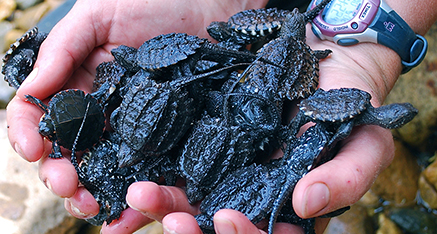Background:
Mercury (Hg) is among the most problematic environmental contaminants globally because of its environmental ubiquity and associated toxicity to humans and wildlife. Turtles possess several traits, including longevity, ectothermy, and various feeding preferences that make them good models for studying Hg bioaccumulation and biomagnification. However, the toxic effects of Hg exposure in turtles have received significantly less attention compared to fish, birds, amphibians, and aquatic mammals.
With many turtle populations declining, euthanizing adults for scientific study is neither sustainable nor conservation-minded, and efforts must be made to implement new non-lethal methods. Development of non-lethal methods will allow researchers to simultaneously collect larger sample sizes while minimizing effects on wild turtle populations. Additionally, for bioaccumulative contaminants, non-destructive sampling techniques will enable investigators to repeatedly sample the same individual to monitor its exposure throughout its lifetime. Sampling multiple tissues will allow researchers to build mathematical correlations between less invasive samples (e.g., nail and blood) to concentrations that can be accumulated in tissues (e.g., muscle and eggs) that are often relevant to overall health, reproductive success, and transgenerational effects attributable to maternal transfer.
Mercury has been shown to maternally transfer from females to their offspring in a variety of vertebrates. As a result, Hg exposure can decrease reproductive output, reduce hatching success, and have lethal and sublethal effects on offspring. While the effects of maternally transferred Hg have been demonstrated in several vertebrate species, nothing is known about the reproductive effects of Hg in turtles.
For this project, we developed and validated non-destructive sampling techniques for assessing mercury bioaccumulation, maternal transfer, and consumption risks in turtles so that future monitoring studies can be performed sustainably. In doing so, we also described demographic, spatial, and temporal factors that influence Hg bioaccumulation in turtles. Finally, because of the known deleterious reproductive effects associated with Hg exposure, we aimed to determine whether Hg exposure negatively affected turtle reproduction and offspring development.

 While the lethal and sublethal effects of Hg exposure are documented in birds, fish, and mammals, the influence of Hg exposure on adult and offspring survival and phenotype is poorly understood in herpetofauna. Understanding Hg bioaccumulation and maternal transfer of Hg is important for assessing the health of turtle populations living in Hg contaminated areas and also protecting humans and other predatory wildlife that consume turtles. The non-destructive sampling techniques we developed will be critical for sustainable monitoring of Hg bioaccumulation and associated health risks in turtles.
While the lethal and sublethal effects of Hg exposure are documented in birds, fish, and mammals, the influence of Hg exposure on adult and offspring survival and phenotype is poorly understood in herpetofauna. Understanding Hg bioaccumulation and maternal transfer of Hg is important for assessing the health of turtle populations living in Hg contaminated areas and also protecting humans and other predatory wildlife that consume turtles. The non-destructive sampling techniques we developed will be critical for sustainable monitoring of Hg bioaccumulation and associated health risks in turtles.